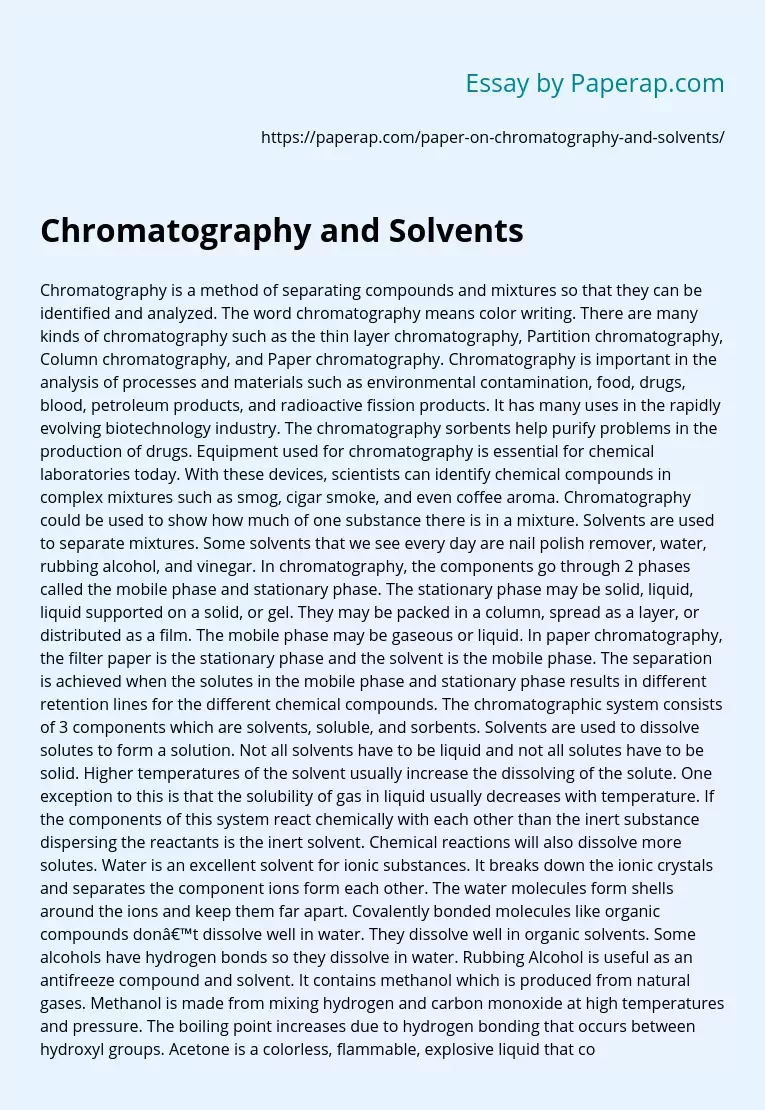Chromatography is a method of separating compounds and mixtures so that they can be identified and analyzed. The word chromatography means color writing. There are many kinds of chromatography such as the thin layer chromatography, Partition chromatography, Column chromatography, and Paper chromatography. Chromatography is important in the analysis of processes and materials such as environmental contamination, food, drugs, blood, petroleum products, and radioactive fission products. It has many uses in the rapidly evolving biotechnology industry. The chromatography sorbents help purify problems in the production of drugs.
Equipment used for chromatography is essential for chemical laboratories today. With these devices, scientists can identify chemical compounds in complex mixtures such as smog, cigar smoke, and even coffee aroma. Chromatography could be used to show how much of one substance there is in a mixture. Solvents are used to separate mixtures. Some solvents that we see every day are nail polish remover, water, rubbing alcohol, and vinegar. In chromatography, the components go through 2 phases called the mobile phase and stationary phase.
The stationary phase may be solid, liquid, liquid supported on a solid, or gel.
They may be packed in a column, spread as a layer, or distributed as a film. The mobile phase may be gaseous or liquid. In paper chromatography, the filter paper is the stationary phase and the solvent is the mobile phase. The separation is achieved when the solutes in the mobile phase and stationary phase results in different retention lines for the different chemical compounds. The chromatographic system consists of 3 components which are solvents, soluble, and sorbents.
Solvents are used to dissolve solutes to form a solution. Not all solvents have to be liquid and not all solutes have to be solid.
Higher temperatures of the solvent usually increase the dissolving of the solute. One exception to this is that the solubility of gas in liquid usually decreases with temperature. If the components of this system react chemically with each other than the inert substance dispersing the reactants is the inert solvent. Chemical reactions will also dissolve more solutes. Water is an excellent solvent for ionic substances. It breaks down the ionic crystals and separates the component ions form each other. The water molecules form shells around the ions and keep them far apart.
Covalently bonded molecules like organic compounds don’t dissolve well in water. They dissolve well in organic solvents. Some alcohols have hydrogen bonds so they dissolve in water. Rubbing Alcohol is useful as an antifreeze compound and solvent. It contains methanol which is produced from natural gases. Methanol is made from mixing hydrogen and carbon monoxide at high temperatures and pressure.
The boiling point increases due to hydrogen bonding that occurs between hydroxyl groups. Acetone is a colorless, flammable, explosive liquid that contains a characteristic odor that can be detected at very low concentrations. 2008). (Chemical compound: CH3COCH3) Used for making nail polish remover, model airplane, and glue. It belongs to a family known as ketones. Ketones are a compound with carbonyl group (carbon and oxygen bonded together) attached to 2 carbon atoms, made of two propane molecules. Acetone may be present in the human body but only in small concentrations. Diabetic patients may have larger amounts. Exposure to Acetone should be avoided because it causes irritation in the eyes and throat. The vinegar is an organic compound that contains up to 5% Acetic Acid (has chemical compounds CH3COOH) and 95% water.
Acetic acid is a clear colorless liquid with a pungent odor. It is soluble in alcohol, acetone, water, and other organic compounds. Vinegar has been used as a cleaning agent, printing of textiles, and as an acidifier to improve the flow of oil from wells. Neil Schlager (2006). Acetic acid is corrosive and prolonged exposure can cause irritation to throat, nose, and eyes. It can also cause headaches, confusion, chest tightness, and coughs. Salt (another name for NaCl sodium chloride) is made from a chemical reaction of an acid and a base. “During this reaction, the acid and base are neutralized producing salt, water and heat. Lerner (2008).
Table Salt (also NaCl) only has one positive ion. Salt is an important compound for preserving food and making soap. It is also very important in the making of chlorine and sodium. Water (H2O) is a chemical compound of hydrogen and oxygen held together by polar covalent bonds. Its polarity causes it to form hydrogen bonds. Hydrogen bonds are an attraction between slightly positive H atoms in a polar molecule with the slightly negative side of another polar molecule. Water molecules form 5 hydrogen bonds and have a high specific heat. Water has a wicking property called capillary action.
Capillary action is the force that draws water out of the roots of plants and into the stems and leaves. Analyzing ink is important questioned documents that might be forged. It could be used to identify inks in forged checks, wills, or altered records. Ink may look the same but they have very different chemical compositions. Ink is made up of a combination of pigments and dyes, oils, and resins. Some inks are even made of soybeans. Inks may be analyzed by a destructive or nondestructive test. The nondestructive is analyzed first and is better because it keeps the paper intact.
Micro spectrophotometry is the main method of nondestructive testing. It scans the ink in infrared and ultraviolet light to record its wavelengths of light it absorbs. Thin layer chromatography is used for destructive testing. A tiny sample of ink paper is punched out and placed on a strip of paper with other ink samples. Then the strip is placed into a solvent but it’s placed where the sample ink is dry. The solvent is drawn up through capillary actions and the sample spots move up with it. The end result is a pattern of colored spots where you can compare it with others to make identification.
Chromatography and Solvents. (2017, Oct 06). Retrieved from https://paperap.com/paper-on-chromatography-and-solvents/

